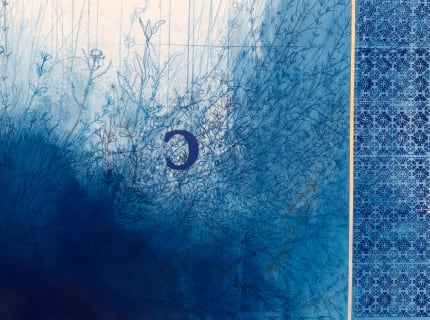Ricardo Brey, born in Havana, is an Afro-Cuban artist working since 1990 in Ghent, Belgium. His show, Doble Existencia / Double Existence, presents works on paper and sculpture, that offers the "double" perspective of someone coming from a culture very different from the one he lives and works in now; it may also be true that "double existence" refers to the double life—internal and external—we experience during the course of our existence. This very good show looks to culture—Dante and the Bible are invoked in Spanish—and to the complex cultural situation Brey finds himself by virtue of being an immigrant, as well as someone in (successful) pursuit of high culture. The sculptures, usually but not always assemblages of found materials, offer a complex point of view that comes both from high modernism and the impoverished economy of Cuba. The works on paper are metaphysical, often painted over with a single color and made intricate by the presence of quotations from Spanish writing. Thus, the overall effect is that of a body of work that lays claim to high aspirations as well as using materials that align with Arte Povera, the Italian movement consciously using "poor" construction elements.
Rose of Jericho (2019), the major work in the show, is a long assemblage laid out on a brown table about four feet high. It consists of one of Brey's open boxes, whose flat leaves are decorated with beautifully patterned paper, a set of two bones, and in the middle, on the top of an uneven pile of paper, a small, dry brown bush weed kept in a glass jar. Following out from one of the flat sides of the box are a series of ink drawings, folded in sequence like an accordion, that are schematic in nature and might relate to the imagery of Marcel Ducham's The Large Glass (1915–1923). The overall experience of Double Existence is quite complex, appearing to relate to the interaction of nature and art. The sculpture is remarkable in its ability to convey a complex, intuitive reality—a combination of culture and nature—that is based in recent art but looks to both micro and macro level levels of the external world. Its title suggests that more is going on in the world than we might know about. The small mask Meditatie (2018) extends from a thin steel support some two feet from the wall; it is carved from wood and partially covered with mosaic tiles. It feels slightly tribal in nature, evidencing a bit of menace that may emanate from the hollow behind the face's features.
Scrub (2018) is a work of orange pigment on paper; it is expressionist and messy in its use of color, with the word "Scrub" emblazoned on the upper-middle-left register of the composition. The word, in English usage, holds a double meaning: the idea of scrubbing something, rubbing a surface with pressure; and the notion of low-level vegetation. As with the title of the show, we are not entirely sure what the artist's intended meaning might be, but the experience of this work on paper is excellent. Densities of color occur mainly in the center of the work, with drips descending downward, toward the very bottom of the drawing. Its general disorganization might well align it with the esthetic of the New York School, although such a reading is distant from Brey's circumstances. Another drawing, employing the same orange hue, is called Fern at the Edge of the Road (2017). An amorphous mass of color, with a darkened center, fills the center of the work; Brey tends to work messily within the color schemes of his two-dimensional art. Perhaps this style functions as a bit of rebellion against the constraints of art that is cleanly made but spiritually lacking.
The astronomical work You will never guess what comes next (2018) consists of a slightly bent bicycle wheel with spheres indicating planets revolving around the wheel's hub. Completed with found objects of varying size, we see this small universe work out a construction of unusual lyricism, accomplished at least in part by Brey's use of street objects. The artist has clearly achieved a lot with a little; he understands, both by intuition and practice, the way a poetics can be achieved by using found, beaten-up materials. This is the key to this excellent show, developed by someone coming from a culture more than a small distance from his own. Yet that doesn't matter; today, methodologies are merging, and only to a slightly lesser degree, cultures as well. Even so, very good artists like Brey show us that art can be made with very little at hand in ways that reflect both personal and impersonal realities.
...
Read full article at brooklynrail.org.

